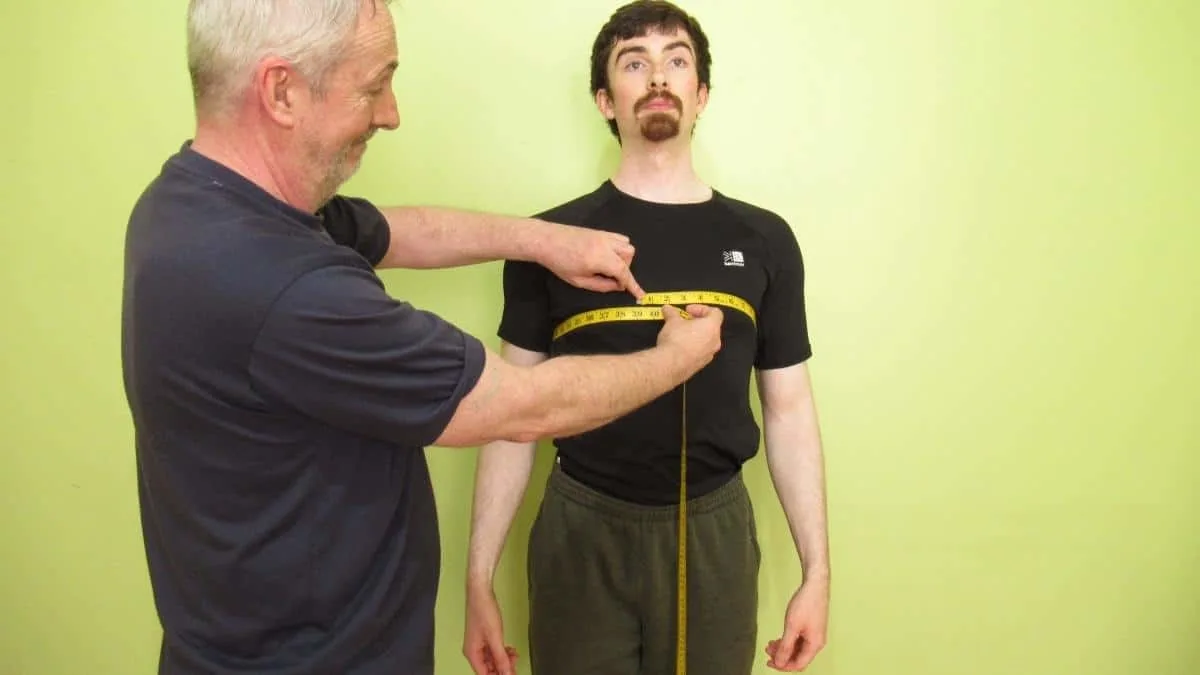If you’re curious about the average male chest size and want to learn how to measure your chest size correctly, then you’re in the right place.
This guide covers both chest circumference and chest width, so no matter how you want to measure your chest, you’ll find all the information that you’re looking for.
See Our Other Measurement Guides:
- Average male height
- Average male shoulder width
- Average male forearm size
- Average male arm size
- Average male leg size
- Average male hip size
- Average waist circumference for males
- Average male calf size
- Average male neck circumference
What is the average chest size for men?
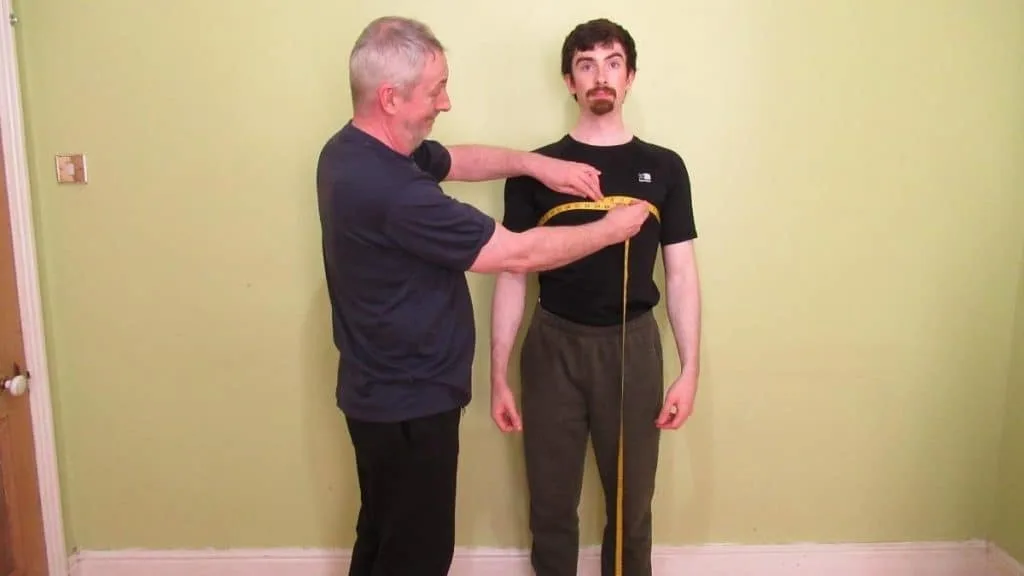
Based on extensive research and measurement of various adult males, the average chest size for men is between 38 inches (96 cm) and 42 inches (107 cm). This is a relaxed measurement taken around the fullest part of the chest in which the chest is not puffed out.
Measurements falling below the average male chest size range are typically considered small, whereas measurements exceeding the range’s upper value are usually considered large or even extra large.
Additionally, the average male chest measurement often differs based on where the man lives, how affluent the society is, and the kind of work that he performs. [1]
For example, male students studying physical education and sports had a larger chest circumference than those studying fine arts or medicine. [2]
So while there’s definitely such a thing as an average chest circumference for men, this average can go up or down depending on the group of males that’s examined.
This fact highlights the importance of contextualizing the data so that healthcare professionals and general population males can accurately assess their anthropometry.
How Does Your Chest Compare?
- 32 inch chest
- 33 inch chest
- 34 inch chest
- 35 inch chest
- 36 inch chest
- 37 inch chest
- 38 inch chest
- 39 inch chest
- 40 inch chest
- 41 inch chest
- 42 inch chest
- 43 inch chest
- 44 inch chest
- 45 inch chest
- 46 inch chest
- 47 inch chest
- 48 inch chest
- 49 inch chest
- 50 inch chest
- 51 inch chest
- 52 inch chest
- 55 inch chest
- 56 inch chest
- 60 inch chest
What is a normal chest size for a boy?

The normal chest circumference for a boy mainly depends on the age of the child. For example, according to data collected in a National Health Survey, the average chest size for a 2-year-old boy is 51.1 cm or 20.1 inches. For a 7-year-old boy, the normal chest size was found to be approximately 60.4 cm or 23.8 inches. [3]
Looking at the ages in between these two points, the average chest measurement for a 3-year-old boy is 52.8 cm or 20.8 inches. For a 4-year-old boy, the average chest measurements were found to be 54.7 cm or 21.5 inches.
Boys aged 5 had a 56.6 cm (22.2 inch) chest on average, whereas boys aged 6 had an average chest circumference measurement of 59.3 cm or 23.3 inches.
Of course, it would be useful to have data that covered a wider range of ages, especially considering the relative ease and lack of invasiveness when it comes to measuring a man’s chest. [4]
One reason for the lack of data on chest circumference may be the fact that other body part measurements (such as the waist) have been identified in research as being more useful for assessing a person’s current health status.
Nevertheless, you can still see the trend. As a boy gets older, his chest circumference gets bigger. I expect that his chest measurement would expand even more rapidly as he reaches puberty.
Men’s chest size charts
Below you’ll find a chest measurement chart for both chest circumference and chest width (also known as a half chest measurement).
These charts will be useful when you’re getting measured for clothes, but be aware that measurements and cut-off points can differ by brand.
Chest circumference chart
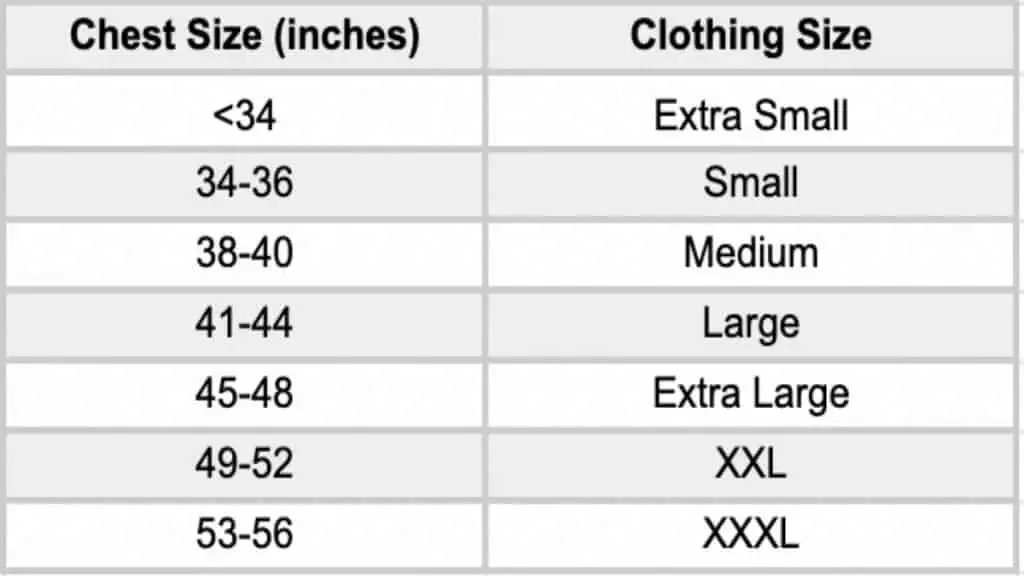
This men’s chest size chart shows a range of chest measurements and their corresponding clothing sizes. If you’re on the cusp of a particular size, then it’s recommended to move up a size if you want a looser fit with more breathing room for your chest.
Also, be aware that an increasing number of brands are making slim-fit clothing. So if you desire a more regular fit, then you may want to make sizing up your rule rather than an exception for when you’re on the cusp of a particular chest size range.
Chest width measurement chart
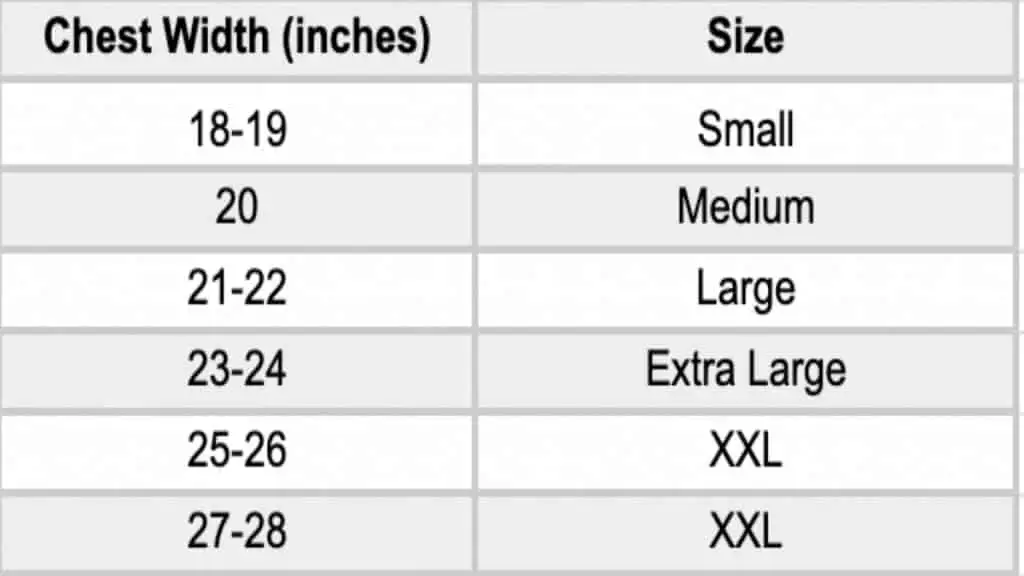
While it’s difficult to perform an exact chest width to chest size conversion, you can use the various sizes (small, medium, large, etc.) on the two charts to work out the ideal clothing size for your chest measurement.
As you’ll learn later on, chest width can refer both to the width of your own chest and the width of a particular item of clothing. Keep reading to learn how to take a chest measurement in both cases.
How to measure your chest size

Learn how to measure your chest size (both chest circumference and chest width) so that you can buy clothes that fit you well and also track your muscle-building or weight loss progress.
To measure your chest as accurately as possible, you’ll need a flexible tape measure and, ideally, another person who can wrap the tape around your chest and back.
While you can measure your chest without any assistance, getting an accurate chest circumference measurement means keeping the tape as straight as possible, something that’s much easier to do when you have someone else measuring your chest.
But first, let’s learn where to measure your chest for the most accurate results—it’s not as simple as wrapping a tape around your chest and then recording the number.
Where do you measure your chest?
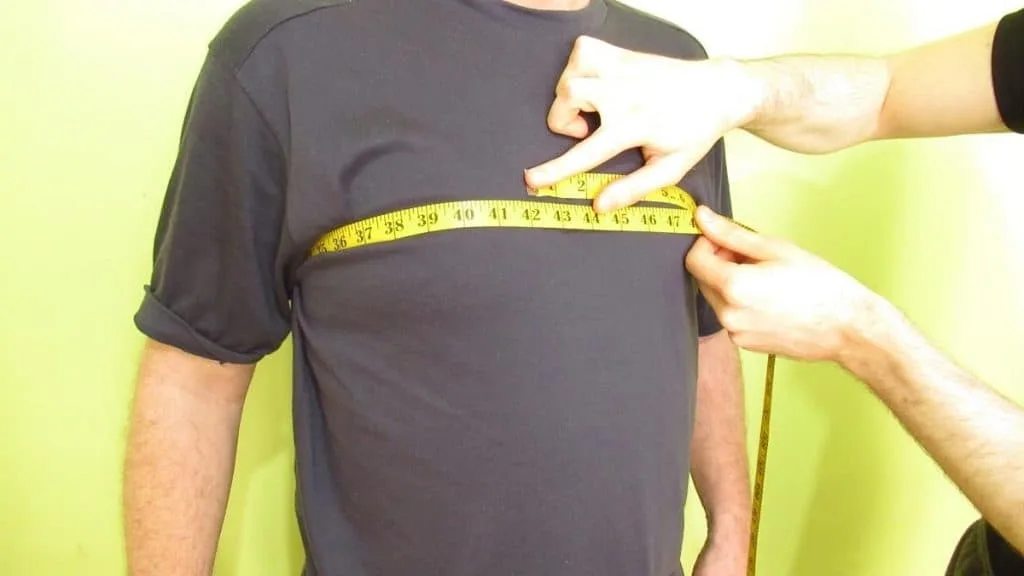
So, where do you measure your chest? For the most accurate results, the correct place to measure a male chest is around the fullest part of the chest, which is usually around the nipple line.
The reason that you want to measure around the fullest part of the chest is so that you avoid buying clothing that’s too tight.
While some men actually want their shirts to be tight-fitting, your clothing will be more comfortable if you have plenty of breathing room.
Now that you know where to take a chest measurement let’s see how to go about the actual measuring.
Chest circumference measurement

Here’s how to measure your chest size with a measuring tape. This measurement will be useful if you’re buying clothing, such as shirts, t-shirts, suit jackets, and hoodies. You can also use your chest circumference measurement to track your fitness progress.
Before we begin, ensure that you’re not wearing multiple layers of clothing. You can definitely take a shirtless chest measurement if you want, but it’s perfectly fine to wear a t-shirt as well.
Additionally, if you’re measuring your chest in order to buy clothing rather than to track your gym progress, you may want to take an inhaled chest measurement to account for the breathing room that you’ll likely want when wearing a shirt.
- Stand up straight with your arms by your sides.
- Lift up your arms and have someone wrap the tape measure around the fullest part of your chest, which is usually around the nipple line.
- Bring your arms back down to your sides.
- Ensure that the tape measure is straight.
- Look at where the two ends of the tape meet—that’s your chest measurement.
- Take another 1-2 measurements so that you can ensure that your chest size is accurate.
Chest width measurement
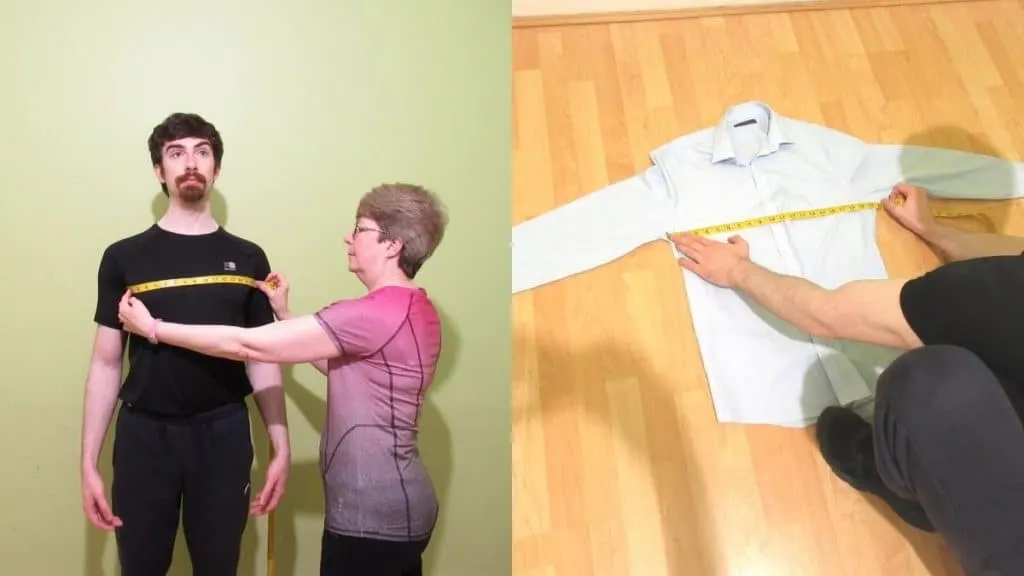
How do you measure chest width? There are two ways to take a chest width measurement; measuring the width of your own chest and measuring the width of a particular garment.
Let’s start with the first option. To measure your own chest width, measure between the skinfold of each armpit, which is to say the points where your upper arms meet your chest. Again, this is best done with assistance, but you can also take your own chest width measurement in front of a mirror.
As our chest width size chart alluded to, many brands specify the chest size of their clothing using the chest width measurement, which is also known as the 1/2 chest measurement.
So to measure the chest width of your shirt or hoodie, lay the garment on a flat and stable surface such as the floor (or on a double bed with the duvet removed). Then, measure between the armpit area on the shirt—this is where the chest and sleeve part of your garment meet.
How to measure your chest size without a measuring tape
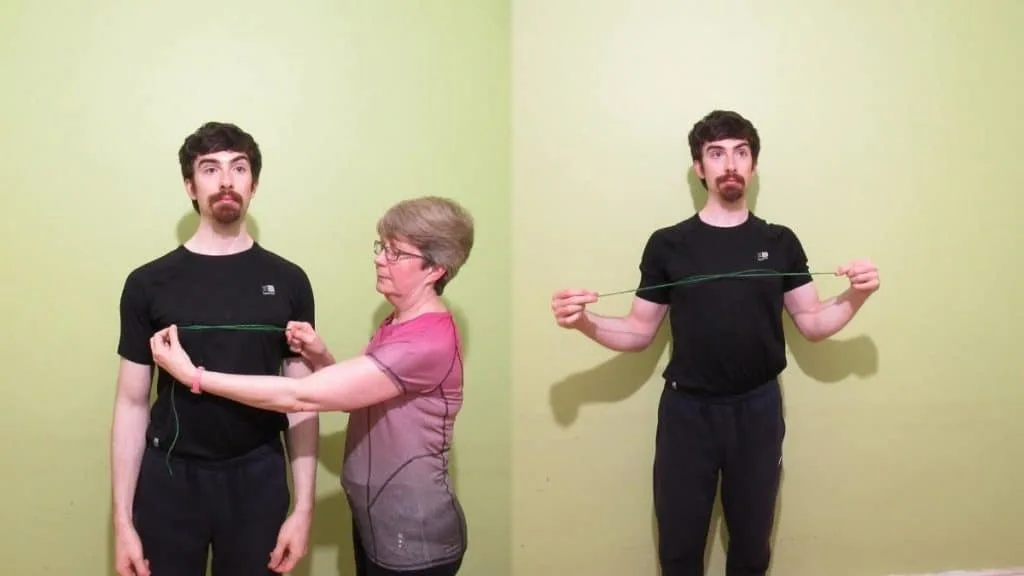
Here you’ll learn how to find your chest size without a measuring tape. Although using a tape measure is the fastest and easiest way to find your chest circumference or chest width measurement, you can still get an accurate reading by using a piece of string.
Essentially, you want to wrap the string around the fullest part of your chest and then mark where the two ends meet. Then, you simply use a ruler to measure between these two points.
Alternatively, you can cut the string once you’ve wrapped it around your chest so that you’re left with only the string that constitutes your chest size.
If you don’t want to do any physical measuring, then you can simply make a best guess of your chest size by looking at the size guide for the clothing that you’re currently wearing.
For example, if your shirt feels tight and it’s designed to fit chests between 38 and 40 inches, then you could make the reasonable assumption that your chest is between 40 and 42 inches.
Chest width vs chest size
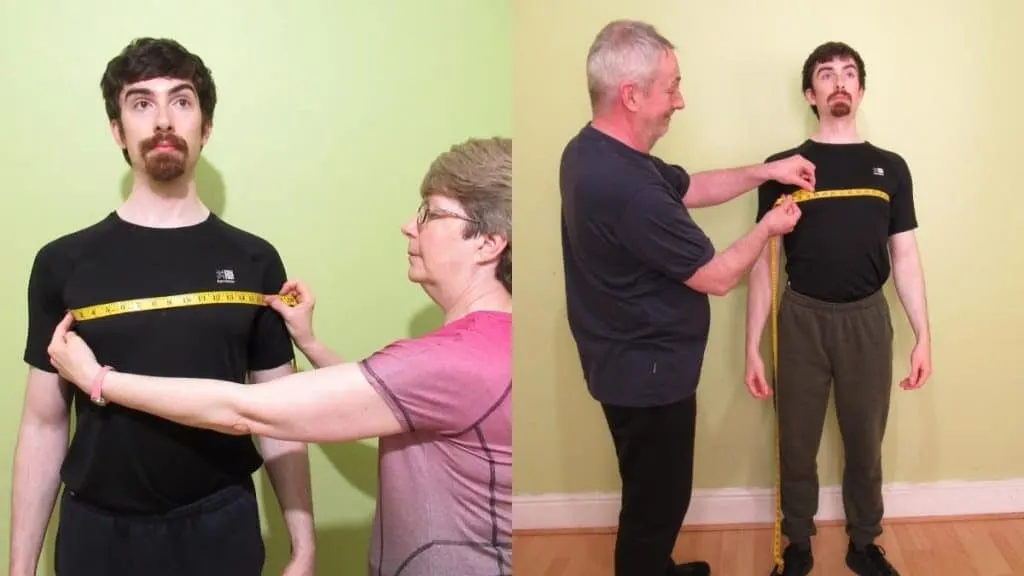
What’s the difference between chest width and chest size? The main difference between chest width and chest size is that chest width refers to the horizontal distance between your armpits, whereas chest size usually refers to chest circumference.
More specifically, chest width is a measurement of the ribcage and pectorals only, whereas chest size factors in the width and musculature of the upper back as well as the ribcage and pectorals.
In general, you should use a chest circumference measurement because you don’t just wear clothes around the front of your chest; you wear them around your back as well.
Granted, brands that opt for the chest width measurement usually factor in the back measurement as well. However, everyone has a different back, so measuring the entirety of the area on which the garment will be worn makes the most sense.
Men’s chest size guide
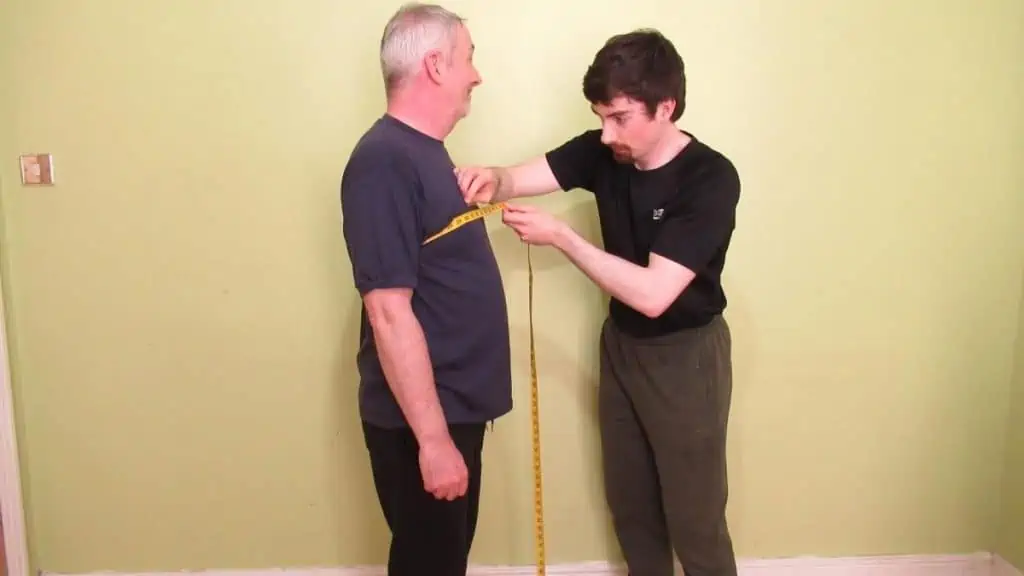
Learn how your chest size measurement corresponds to the various clothing sizes.
What chest circumference measurement is a size small?
In general, a chest that measures between 34 inches and 36 inches in circumference is considered small. If your chest measurement is less than 34 inches, then you’ll likely be an extra small.
What is considered a medium chest size for a man?
What chest size is a medium? For a man, a medium chest size is usually between 38 inches and 40 inches (96 cm to 102 cm).
What is considered a large chest size for men?
What chest size is a large? A men’s large chest size is between 41 inches and 44 inches (104 cm to 112 cm).
What chest size is an XL?
What chest size is XL? In most clothing brands, a chest size of 45 inches (114 cm) to 48 inches (122 cm) is considered a size XL (extra large).
Chest circumference FAQ
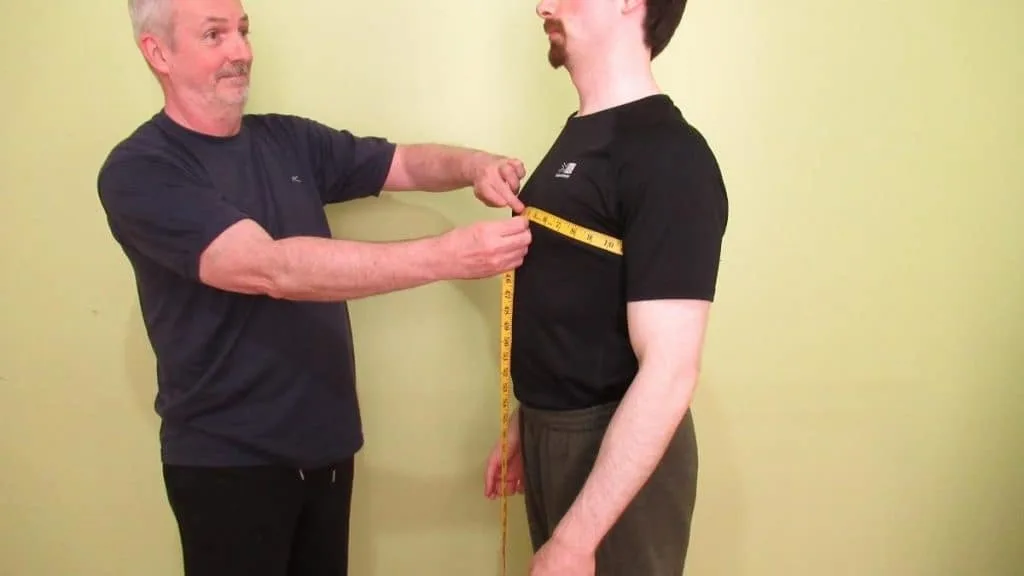
Now that you know the average chest size for men and how to take chest measurements accurately, it’s time to get into the finer chest circumference details so that we leave no stone unturned.
What is a good bodybuilder chest size?
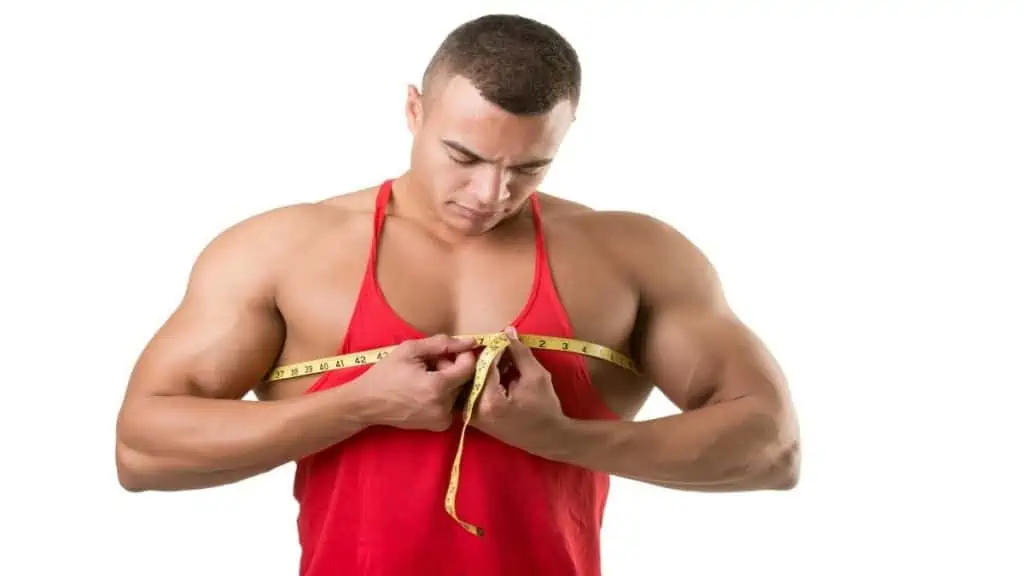
What is a good chest measurement for bodybuilding? In general, a good bodybuilder chest size is 40 inches or more. Anything over 45 inches is very big, and anything bigger than 50 inches is huge.
These measurements apply if your chest is relatively lean. While you definitely don’t need to be shredded in order to have a good chest, no bodybuilder should be fat—the majority of your chest size should consist of muscle mass.
If you fall outside of these values, then that’s not necessarily a bad thing. For example, if your chest measures 38 inches but is really lean, then you’ll definitely have a very muscular chest. It just won’t be bodybuilder-level massive, that’s all. You don’t need the biggest chest ever to look great!
Now, if you’re on the other end of the spectrum and have in excess of 50 inches of chest girth, then it could be because you have excess fat around your chest (or have a massive back as well).
Additionally, it could be because you have a large ribcage. Very few natural lifters will be able to build a chest that big.
What is a good chest circumference for a male model?
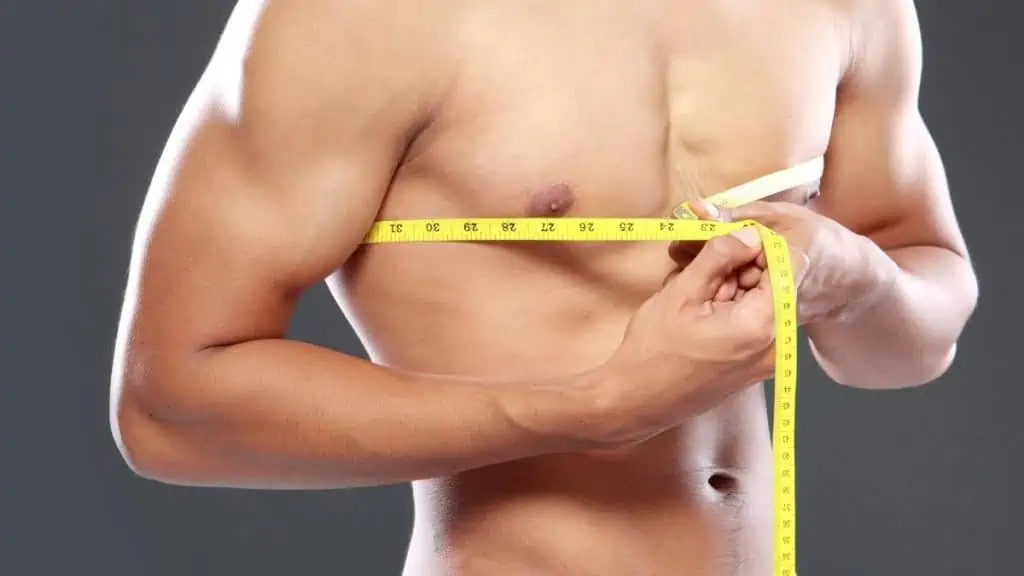
It depends on the kind of modeling that you’re doing. If you’re a fashion model, then a chest size of 38 to 40 inches would likely be the ideal male chest size.
Of course, depending on the look that fashion brands are after, it’s likely that you could still be a successful model if your chest circumference falls a couple of inches outside of this range.
However, given that male models are usually over 6 feet tall, having an excessively small chest may mean that you’re too skinny and possibly underweight.
On the other hand, if you want to be a fitness model, then shoot for a chest size of over 40 inches (over 42 inches is even better) while trying to stay relatively lean.
What is the ideal chest size for a male?

The ideal chest size for a male is between 38 inches and 42 inches. If you’re really tall or really short, then your chest circumference may fall outside this range.
Still, having a medium to large chest in terms of circumference measurement will enable you to look lean and muscular (and thereby aesthetic) while maintaining good health.
Standards of aesthetics differ around the world and may change throughout the years, so these values aren’t set in stone.
Still, if your chest is lean and measures between 38 and 42 inches, then it will look muscular and well-built without being too big.
What is the average male chest size by height?
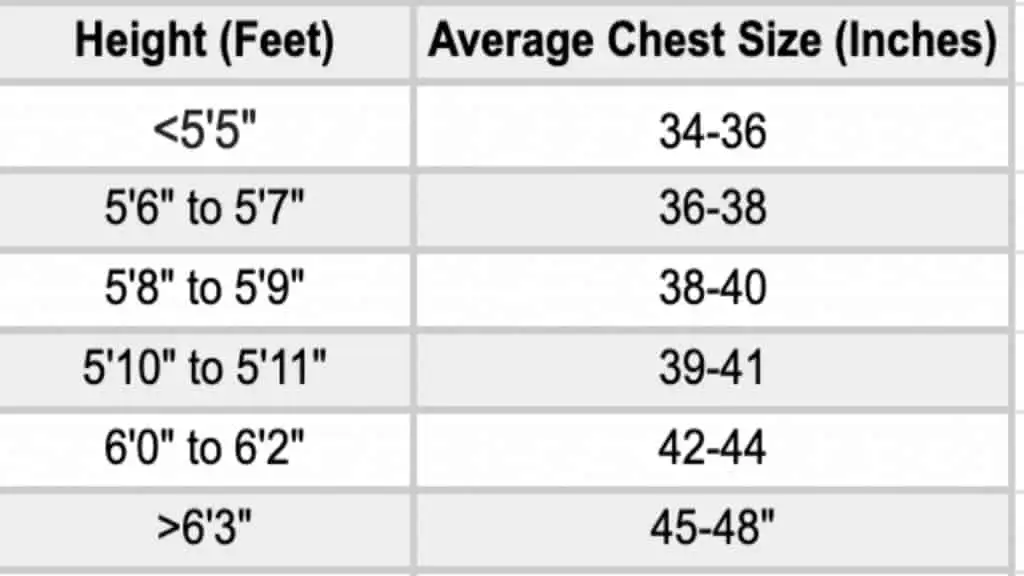
Although there is virtually no good data that examines the average male chest size by height, we do know that chest circumference tends to increase with height because taller people have larger ribcages than shorter people, which gives them a bigger chest measurement.
The above male chest size chart gives what we strongly believe to be accurate chest measurements based on height. While there are sure to be outliers, these measurement ranges are accurate for most males raised in Western nations.
What is the average chest size by age?

Since there are no good studies that examine the average chest size by age, it’s difficult to give precise values.
However, we know that chest size tends to increase into middle age—commonly as a result of body fat accumulation—and then decreases as a man reaches old age and loses muscle mass.
While there are studies examining chest circumference in certain age ranges (such as boys aged 2-7), there just isn’t much anthropometric data looking at a wider variety of age ranges.
Still, the above trends are accurate. However, they can be altered by lifestyle changes such as resistance training.
Lifting weights can build upper body muscle mass during young adulthood and also prevent the loss of muscle mass during old age, both of which will contribute to a larger than average chest size for that particular age group.
What is the average chest size for a 20 year old male?
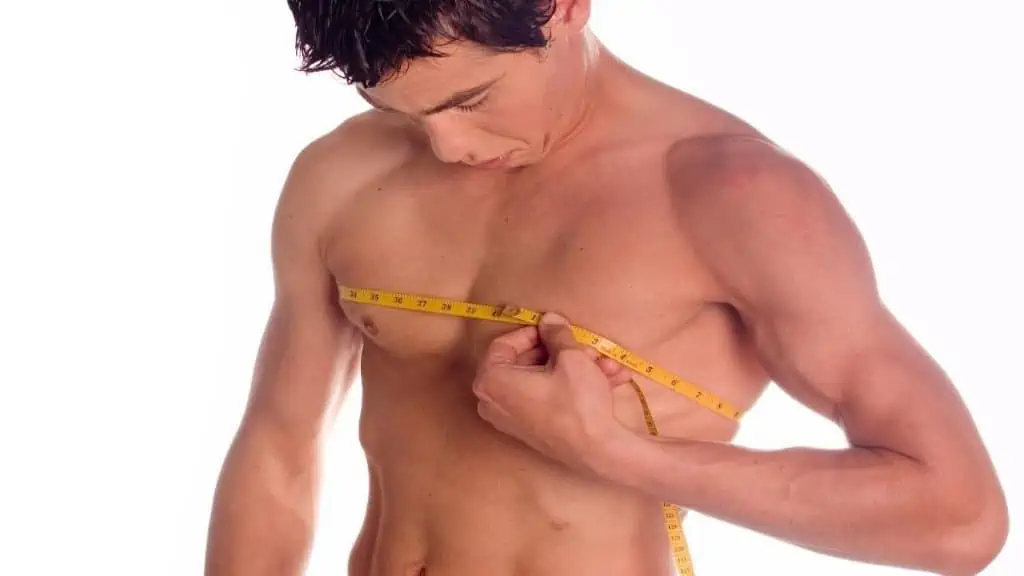
Based on the data, the average chest size for a 20 year old male is between 38 inches and 40 inches. This also holds true for most young men between the age of 18 and 25.
Of course, depending on your height and levels of muscle mass, you might fall outside of this fairly narrow range, and that’s okay if it’s only by a couple of inches.
Refer to the average chest size by height chart above if you want to know the ideal chest size for males of your height.
What is the average chest size for a 5’8″ male?

Since a 5’8″ male is ever so slightly shorter than average, he will likely have a chest size on the lower end of the average, which is to say between 38 inches and 40 inches.
If the man is very slim, then his chest could be as low as 36 inches. This is perfectly fine unless the measurement is indicative of him being underweight.
Conclusion: Should you strive for a normal chest measurement?
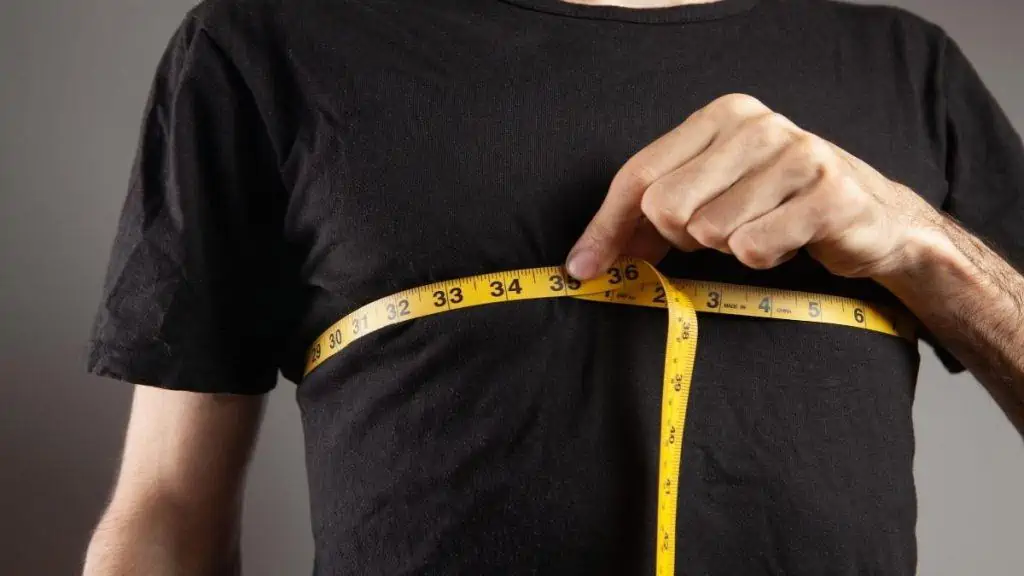
An increasing number of men desire a thick and muscular chest that commands attention. So, in a muscle-hungry world, is it okay to strive for a normal chest measurement?
Absolutely!
While there’s nothing wrong with building yourself up and gaining muscle—indeed, building muscle is great for longevity—you can still enjoy your best health while having a very average chest size. [5]
In general, if your chest measures between 38 and 42 inches, then you’re in the sweet spot.
A given chest circumference measurement is only bad when it’s indicative of health problems, such as you being underweight or overweight.
References
- Kryst, Ł., Woronkowicz, A., Kowal, M., & Sobiecki, J. (2017). Intergenerational changes in chest size and proportions in children and adolescents aged 3-18 from Kraków (Poland), within the last 70 years. American journal of human biology : the official journal of the Human Biology Council, 29(2), 10.1002/ajhb.22918. https://doi.org/10.1002/ajhb.22918
- Cingi, C., Muluk, N., Hanci, D., Güngör, E. & Cingi, C. (2016). Is there a correlation between body proportion and choice of profession?. International Journal of Adolescent Medicine and Health, 28(2), 175-182. https://doi.org/10.1515/ijamh-2015-0008
- National Center for Health Statistics, M. F. Najjar and M. Roland: Anthropometric Reference Data and Prevalence of Overweight, United States, 1976-1980. Vital and Health Statistics. Series 11, No. 238. DHHS Pub. No. (PHS) 87-1688. Public Health Service. Washington. U.S Government Printing Office, Oct. 1987
- Komenda S. (1989). Body mass indices based on the chest diameters. Acta Universitatis Palackianae Olomucensis Facultatis Medicae, 122, 387–397.
- Artero, E. G., Lee, D. C., Ruiz, J. R., Sui, X., Ortega, F. B., Church, T. S., Lavie, C. J., Castillo, M. J., & Blair, S. N. (2011). A Prospective Study of Muscular Strength and All-Cause Mortality in Men With Hypertension. Journal of the American College of Cardiology, 57(18), 1831–1837. https://doi.org/10.1016/j.jacc.2010.12.025

